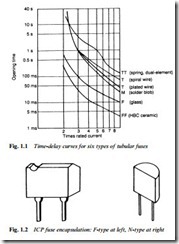INTEGRATED CIRCUITS
Most of the components described so far (but primarily semiconductor devices) can be formed on a silicon wafer substrate in subminiature form with very high density to form integrated circuits (ICs), whose advent and development is alone responsible for the very advanced state of consumer electronics, and the low – in real terms – cost of equipment.
ICs fall into two main groups, analogue and digital, with many subdivisions in each. Analogue ICs used in TV and video sets are almost invariably purpose-designed for the role they play: field time- bases, PAL decoders, audio power amplifiers and scan-timing genera- tors in TV sets; f.m. modulators/ demodulators, colour-under processors, motor drivers and audio record/playback amplifiers in VCRs; and power-supply regulators, i.f. amplifiers and video demodulators/amplifiers in both. High-power IC amplifiers, usually driving ‘magnetic’ loads, have heat sinks and can provide powers up to many tens of watts.
Digital ICs have a huge variety, and most of those used in home- entertainment equipment fall into these four classes: general-purpose chips, containing relatively simple counting, logic and switching functions, used as ‘building blocks’ of a system; microprocessors, generally used for overall control and co-ordination of the functions of a complete unit, many of which are mask-programmable to suit specific products, with the ‘software’ denoted by a suffix to the type number; peripherals, which typically interface microprocessors to other devices like display panels, memory chips and data buses; and memories, which can be as simple as a 1Kbit RAM for tuning data storage or as complex as a 2Mbit DRAM capable of holding a complete TV field in digital form. Many ICs are static-sensitive: see static precautions in Chapter 23.
FUSES
Fuses and fusible devices are essential for protection against overheating, damage, fire and shock. The most common type of fuse is the 20 × 5 mm glass type, which comes in five classes, TT, T. M. F. and FF, in ascending order of operating speed (See Fig. 1.1). Glass fuses are available in current ratings from 32 mA upwards, the rated current being the one which the fuse can carry continuously without degradation. To blow the fuse a much higher current must be passed for a period depending on the ‘time’ rating of the fuse. This minimum fusing current is typically 50–100% more than the rated current. All fuses have internal resistance and hence a voltage drop while in operation; fast fuses have higher resistance than delay types, and a drop of 1 V across an HBC fuse rated at (and carrying) 500 mA is normal. Delay fuses are used where inrush or transient currents are expected to significantly exceed the normal steady-state current.
ICP (Integrated Circuit Protector) fuses are commonly used in consumer equipment. They are plastic-encapsulated in the shapes shown in Fig. 1.2. They are fast-acting (200 ms at 300% current) and non-polarised, with low voltage drop and low (50–150 V) voltage ratings. The figure following the type letters must be multiplied by 40 to give the rated current in milliamps: thus an ICP-N15 is a 600 mA and an ICP-F10 is a 400 mA type.
PRINTED CIRCUIT BOARDS
PCBs are the basis of virtually all electronic assemblies. A PCB consists of a substrate of SRBP (Synthetic Resin-Bonded Paper) or epoxy-bonded glass fibre, 1–2 mm thick, with a network of copper conductors, about 35 microns thick, ‘printed’ on its surface. The cop- per pattern has lands or pads aligned with the legs and leadouts of the components, which both secure them and connect them to the board. Conventional PCBs have all the components on one side, and
the printed pattern on the other, with all the legs and leadouts pass- ing through holes in the board. A later development uses a print- through-holes technique, which permits higher-density packing by virtue of having conductors on both sides of the board. In domestic products SRBP boards are conventionally used for economy. They have a lower operating temperature (85°C) than fibre boards (120°C) and a risk of carbonisation under fault conditons, which can render the board conductive.
A variant of PCB technology is the surface-mounting (SM) assembly, in which subminiature components and printed conductors share the same surface, permitting both sides of the board to be densely covered. Through-board links provide interconnections as necessary. SM assemblies have many advantages for the manufacturer and user: their high-frequency performance (e.g. in tuners) is good; and they offer very high packing density (tiny but complex products) and consistent and reliable performance. The components have to be able to withstand solder-flow temperatures, and must be very accurately placed on the board during manufacture. All components, active and passive, are available in SM versions, and resistors and capacitors are typically 2 × 1.25 mm outline. Value-coding for these devices is listed in Chapter 24, and Fig. 1.3 gives an example of the use of SM PCBs in a consumer-market camcorder. Practical advice on servicing PCBs and SM devices is given in Chapter 23.
SOLDER
Most electrical joints, on PCBs and elsewhere, are made with solder, which for general purposes is a 60/40 alloy of tin and lead with a melting point around 183°C. For applications where operating temperatures may approach this, high melting point (HMP) solders are available. Solders are generally prepared in wire form with one or more internal cores of non-corrosive flux. For general servicing purposes 18 or 22 s.w.g. is suitable, though finer grade (26 s.w.g.) is useful for fine work and for rework of SM PCBs. Special-purpose solders also relevant to these are various preforms, and solder paste, in which tiny globules of solder are suspended in a semi-liquid flux and dispensed onto the board as required during manufacture or repair, in the latter case from a syringe. All soldering is accompanied by fluxing, the application of an agent (e.g. resin) to remove oxides from the surfaces of both metals to be bonded.

